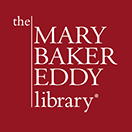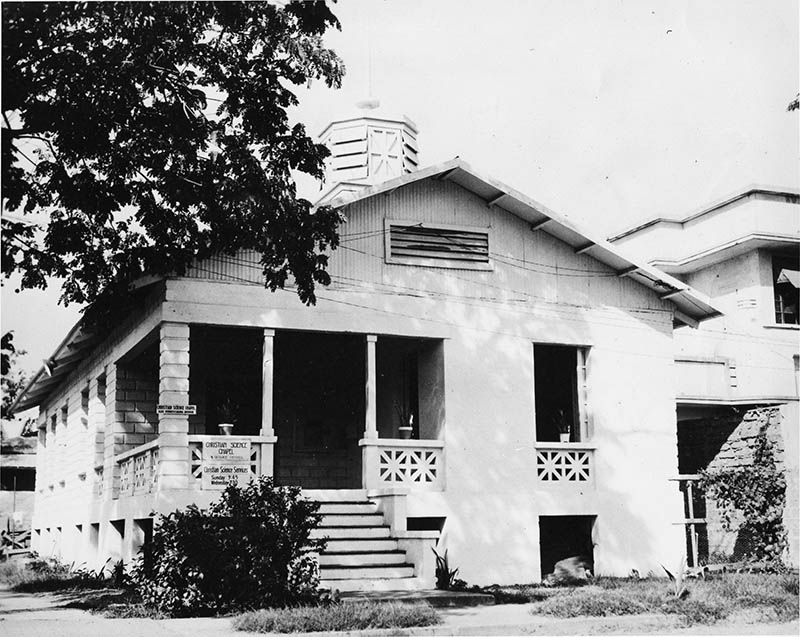“When we make up our minds to build a church, we do it”
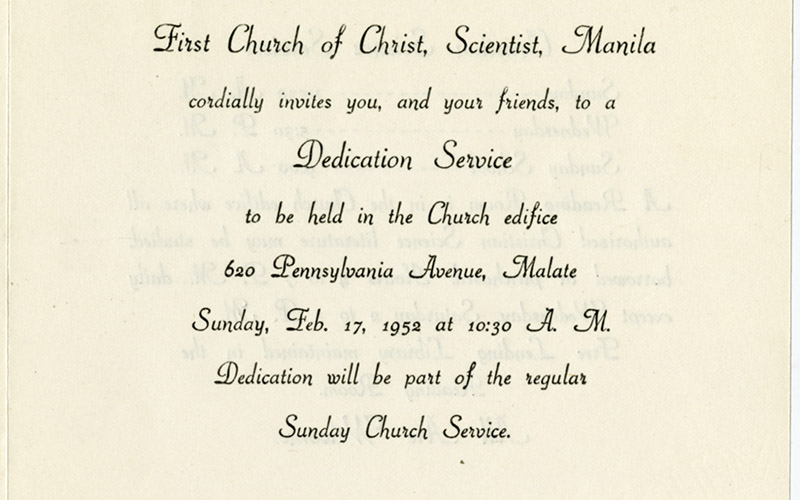
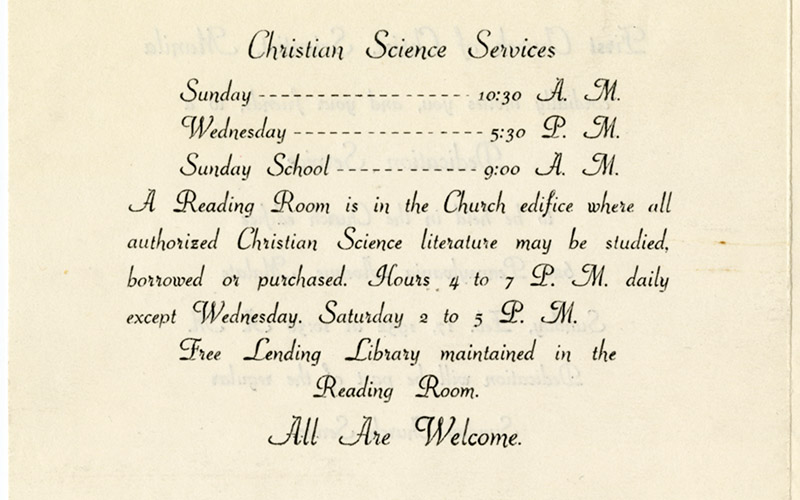
“Dedication Invitation for First Church of Christ, Scientist, Manila,” undated, Church Archives, Box 530749, Folder 221332.
On February 17, 1952, the new building of First Church of Christ, Scientist, Manilla, the Philippines, was dedicated. This was a special moment. It had been just over 50 years since the first Christian Science services were held in that city. Throughout the trials of the Second World War, members of the Manila church held services in the face of incredible challenges, and then rebuilt their church from the ashes of the conflict.
“First Church of Christ, Scientist, Manila,” February 1, 1949, Unknown photographer, Church Archives, Box 530749, Folder 221332.
As early as 1900, Mary Baker Eddy pointed out that Christian Science already had “a hearing and following” in the Philippine Islands.1 The first services in the Philippines were held in 1901 in Manila, in the home of an Army officer stationed there. In 1903 the group organized as a Christian Science Society and purchased a lot at 620 Pennsylvania Avenue, which would serve as the site of the church, its Sunday School, and its Reading Room. On June 25, 1917, the Society was recognized as First Church of Christ, Scientist, Manila. Services were held regularly until Japan invaded the Philippines in December 1941, drawing the country into the Second World War. 2
On December 8, the day after the Japanese bombed Pearl Harbor, the Imperial military attacked the Philippines, destroying American aircraft at Clark Field. On December 22, Japanese troops began invading and on May 6, 1942, American forces in the Philippines surrendered. 3 The Philippines became the site of major conflict throughout the war, as Filipinos and Americans resisted the Japanese occupation. Over 260,000 Filipinos engaged in guerilla warfare against the Japanese, and all fighters in the Philippines relied on villagers around the country. Over one million Filipinos and more than 60,000 Americans died during the Japanese occupation. 4
In the face of all of these challenges, the Christian Scientists of Manila turned to each other and their faith. Christian Scientists in the Santo Tomás Internment Camp maintained a Reading Room and held Sunday services for over 20 people. 5 They even shared their literature with students in Los Baños Internment Camp. The 1943 Thanksgiving service at Los Baños was remarkable. “Prayer for Country and Church,” from Christian Science versus Pantheism by Mary Baker Eddy, was read, and every member present gave a testimony about how Christian Science had helped them. 6
American forces retook Manila on March 4, 1945, but the costs were high. The Battle of Manila lasted a month, and approximately 100,000 people died in the conflict. The city was nearly destroyed by bombing.7 After the battle, three walls were all that remained of First Church, Manila.
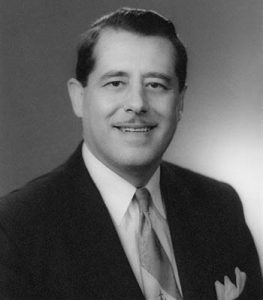
“Studio portrait of Clifford R. Nysewander,” December 18, 1956, Photoflex Studio, Church Archives, Box 534080, Folder 336262.
Volunteer Wartime Workers came together with interested students in the Armed Services, to face the challenge of rebuilding.8 One leader of this effort was Clifford R. Nysewander, a chaplain who had recently arrived to supervise Christian Science activity in the Philippines.9 Nysewander had become a full time Christian Science practitioner in 1937, enlisted in the U.S. Army during the war, and attained the rank of major during his service as Philippine Base Station Chaplain.10
Under Nysewander’s guidance, a Chapel and Service Center took form and parties were organized to reconstruct the church buildings.11 Immediately after Sunday services, members of the congregation would go to the building site to clear away debris and prepare for the construction of a new building. It took nearly a month to clear the site and allow construction to begin. One of the most significant challenges they faced was the lack of building materials. The group gathered old Jeep cases, crates, and packing boxes.12
Construction parties were made up of anyone who could possibly handle the work, including majors, captains, lieutenants, and G.I.’s. The Wartime minister and the chaplain worked as well, as did many women.13 One of the workers later recalled the construction:
The good work started. First we needed lumber, and it was provided by some officers who knew the right people. Then we needed transportation to get the lumber to the church, and it was provided. The tin for the roof, and electric wiring and someone put it up. You know, when we Christian Scientists make up our minds to build a church, we do it. So you take that desire, and a bunch of G.I. personnel, Red Cross workers, Wacs, and officers, and it does not take long to get the job done.14
The temporary building was soon completed, and two dedicatory services were held on October 14, 1945, with approximately 170 people in attendance.15 Church members continued the work, and makeshift building materials were replaced over time with Philippine hardwood.16 At the 1952 dedication of the reconstructed edifice, the following passage from the “Glossary” definition of Church in Science and Health with Key to the Scriptures was read:
The Church is that institution, which affords proof of its utility and is found elevating the race, rousing the dormant understanding from material beliefs to the apprehension of spiritual ideas and the demonstration of divine Science, thereby casting out devils, or error, and healing the sick. 17
- Mary Baker Eddy, Message to The Mother Church for 1900, 1.
- “The History of First Church of Christ, Scientist, Manila” n.d., Church Archives, Box 530749, Folder 221332.
- “World War II in the Philippines: A Timeline,” The Los Angeles Times, last modified December 2, 2012, http://articles.latimes.com/2012/dec/02/travel/la-tr-philippines-timeline-20121202.
- “Bataan Rescue,” PBS Online, accessed March 27, 2017, http://www.pbs.org/wgbh//amex/bataan/peopleevents/p_filipinos.html.
- “Supplement to History,” n.d., Church Archives, Box 530749, Folder 221332.
- The Story of Christian Science Wartime Activities, 1939-1946 (Boston, MA: The Christian Science Publishing Society, 1947), 307.
- “World War II in the Philippines: A Timeline,” The Los Angeles Times, last modified December 2, 2012, http://articles.latimes.com/2012/dec/02/travel/la-tr-philippines-timeline-20121202.
- “Supplement to History,” n.d., Church Archives, Box 530749, Folder 221332.
- The Story of Christian Science Wartime Activities, 308.
- “New Members of The Christian Science Board of Lectureship,” Christian Science Sentinel, June 30, 1956, 1127-1128.
- The Story of Christian Science Wartime Activities, 309.
- “Christian Scientists in Forces Build Chapel and Service Center at Manila,” The Christian Science Monitor, January 11, 1946, 11.
- The Story of Christian Science Wartime Activities, 310.
- Ibid., 309.
- Ibid., 311.
- “Supplement to History,” n.d., Church Archives, Box 530749, Folder 221332.
- Mary Baker Eddy, Science and Health, 583.
